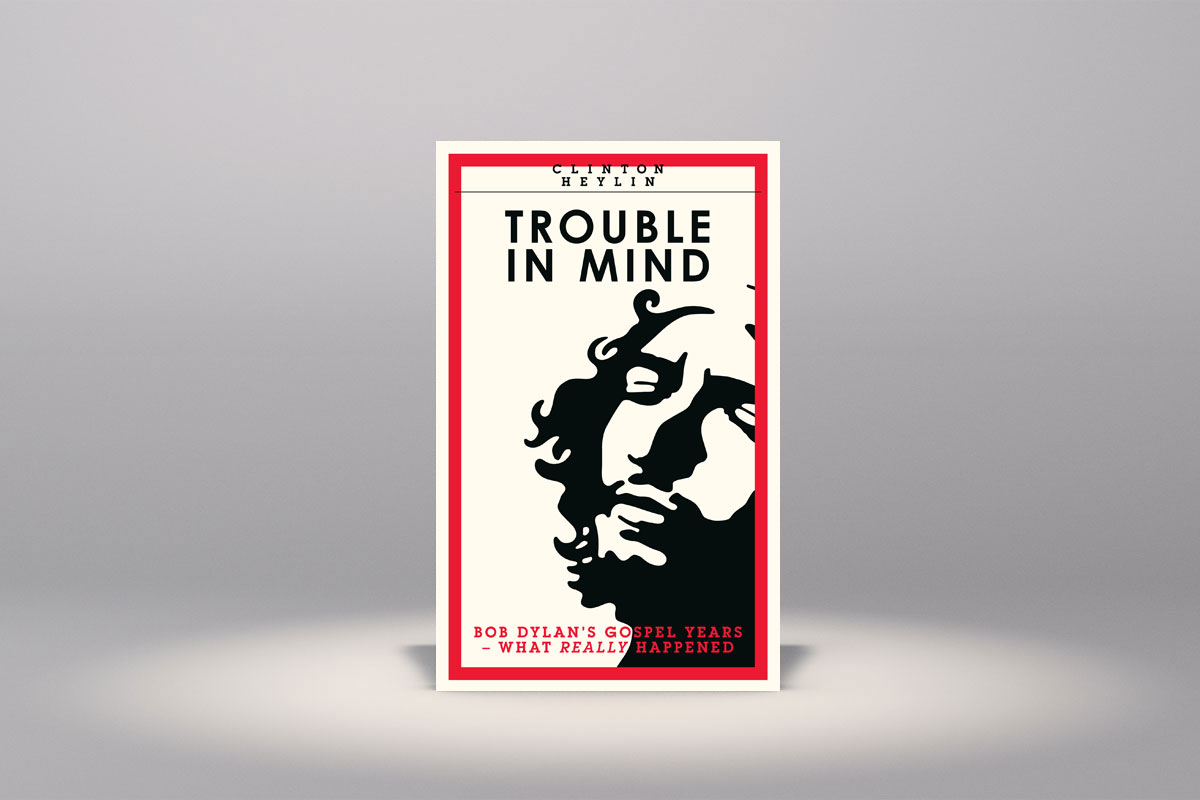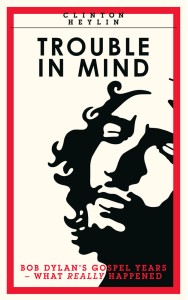Clinton Heylin's introduction to his book Trouble In Mind: Bob Dylan's Gospel Years - What Really Happenend.
I never felt like I was searching for anything. I always felt that I’ve stumbled into things or drifted into them. But I’ve never felt like I was out on some kind of prospector hunt, looking for the answers or the truth … I never went to the holy mountain to find the lost soul that is supposed to be a part of me … I don’t feel like a person has to search for anything. I feel like it’s all right in front.
—BOB DYLAN TO DENISE WORRELL, 1985
Caveat emptor: I am an evangelist. That is to say, when it comes to the evangelical part of the Dylan canon – what in mediaspeak has been defined, rather misleadingly, as the gospel years (i.e. 1979-81) – I’m a believer. Not a trace of doubt in my mind.
From the moment I heard a live performance of ‘Covenant Woman’ from the November ’79 Warfield shows at a one-day Dylan convention in Manchester the following month, I knew the man had (re)connected to the wellspring of his art when that ol’ sign on the cross began to worry him.
As I have long argued, in person and in print, the consummate songwriter composed a body of work in the period 1979-81 which more than matches any commensurate era in his long and distinguished career – or, indeed, that of any other twentieth century popular artist.
But unlike that other seminal starburst of inspiration, the one between 1965 and 1967, the afterglow of this cerebral explosion is barely reflected within the grooves of the trilogy of albums CBS released in real time: Slow Train Coming (1979), Saved (1980) and Shot Of Love (1981).
Perhaps it’s because Dylan’s heart really wasn’t in the process of making records at the time. He did, after all, suggest in an interview designed specifically to promote the third album in said trilogy, that his primary interest was playing ‘songs which [a]re gonna relate to the faces that I’m singing to. And I can’t do that if I[‘m] spending a year in the studio, working on a track. It’s not that important to me. No record is that important.’ Said interview appeared on a CBS promo album.
The epicentre of Dylan’s artistry at the cusp of the decades – as it had been in the mid-seventies – was the stage; surely one reason why, starting in November 1979, he took an acetylene torch to the 1978 set list and began afresh. As he said at the time on his one radio interview, quoting 2 Corinthians, ‘All things become new, old things are passed away.’
To howls of protest that couldn’t help but remind one of the folk-rock furore thirteen years earlier, he delivered the same unrelenting Good News/Bad News message night after night, while each night becoming born again as a performing artist in front of the aghast eyes and ears of Dylan apostates.
Just as from September 1965 to May 1966, the shows which ran from November 1979 to the following May saw the gospel gauntlet thrown down nightly. Dylan delivered an unceasing barrage of biblical glossaries set to the soundtrack of a heavenly choir and a band of unbelievers riding the musical tide all the way to New Jerusalem. But this time there was no near-death experience to deflect Dylan from his chosen path. He would continue beating his ecumenical drum most of the time for the next eighteen months.
For much of this period, his was very much a voice in the wilderness. Much of the media, and a large percentage of his hardcore fan base, simply switched off. The North American gospel shows – All Saints’ Day ’79 at the San Francisco Warfield excepted – tended to receive only local reviews, and rarely drew ones interested in reporting the facts.
As for the shows themselves, journalists delighted in reporting that this ‘voice of a generation’ couldn’t even sell out intimate theatres. Even the eight English shows in July 1981 struggled (and failed) to sell out, barely three years after people were camping out for 72 hours just to get a single ticket for six Earls Court shows.
(Those arch-arbiters of fan demand, the bootleggers, were also switching off just as Dylan’s muse was switching on again, deeming demand to be insufficient from a demographic of wavering disciples.)
So, although Dylan played some ninety-eight shows between November 1979 and December 1980, all but a handful of which were still being taped by hardcore collectors, not a single vinyl bootleg was released in real time; and this, from the most bootlegged rock artist of all time. As for official album sales, the cliff Dylan fell off in 1980 with the catastrophic Saved was one it would take him seventeen years to scale again.
So, on the face of it, hardly the sort of period where a thorough revisit would send ripples of excitement through the Dylan world in 2017. And yet, when at the start of the year Dylan’s long-time manager hinted to a Rolling Stone reporter that the next Bootleg Series (lucky thirteen!) would re-examine the gospel years afresh, the fan sites were abuzz with anticipation.
Because, as a Nobel poet once put it, ‘Everything passes, everything changes.’ And three decades on, an official release (or two) of a judicious sample of one or two legendary residencies in San Francisco, Los Angeles, Toronto, Montreal or London ranks high on most Bobcats’ bucket lists.
Ranking higher still for those whose focus is the studio oeuvre is a set that also affords a thorough re-examination of the two dozen songs Dylan wrote in the six months leading up to the Shot Of Love sessions. With 20/20 hindsight, the album bearing that name – even though it has real moments – stands as perhaps the most underwhelming Dylan studio collection of original songs to date, with maybe three performances on the official Shot Of Love worthy of inclusion on the double-album it should have been: the title track itself, a ‘Property Of Jesus’ that aside from a remix could hardly be bettered, and ‘Every Grain Of Sand’.
The good news – praise the Lord of Happenstance – is that the period 1979 to 1981 turns out to be among the best documented eras in Dylan’s six-decade-long career as a recording/ performance artist.
The explanation for this resides in two events dating back to January 1978: the purchase of a brand-new, state-of-the-art, eight-track tape machine made by Otari, the MX-5050, shortly after Dylan had signed a five-year lease on a rehearsal studio in downtown Santa Monica.
These serendipitous twists of fate meant Dylan could begin to record most rehearsals at his newly leased studio; demo songs he wished to copyright; as well as run tapes of all the shows he was to perform during a 115-date world tour. The rehearsal studio, known privately as Rundown, throughout this period would even serve as a sometime-recording studio for the two albums which bookend the Rundown era, Street-Legal and Shot Of Love.
Indeed, Dylan soon grew so comfortable with his Santa Monica ‘home studio’ set-up that he rekindled a work ethic last seen in the happy days spent in the Big Pink basement in West Saugerties, New York, with the last standing band he kept on retainer, the mostly-Canadian Hawks, back in 1967.
Having put together the second standing band of his career in September 1979, it should come as no great surprise that the dividing line between tour rehearsals, album sessions and copyright demos for the next two years would be as fuzzy as one of Fred Tackett’s effect-pedals; or that the aesthetic of the basement tape should be so readily revived by its instigator twelve years on, with a set of musicians no less accomplished than The Band and perhaps even more sympathetic to Dylan’s way of working on the hoof.
In those two years, the body of work Dylan and his band captured at Rundown Studios, between tours (and albums), is in many ways more impressive than the one he and The Band managed from their 1967 country retreat. The breadth of material tackled, if presented in its entirety, would certainly challenge that now available on the official ‘basement tapes’ Bootleg Series.
At least Trouble No More – the next Bootleg Series – more than hints at a Rundown facsimile of the ‘lost’ album Dylan could have recorded in the fall of 1980 – but didn’t! Frustratingly, when Dylan did finally enter the very same rehearsal studio where he demoed an album’s worth of new songs six months earlier, to begin the new album in March 1981, he had already discarded half a dozen strong compositions and begun to bastardize the lyrics to two defining post-conversion masterpieces, ‘Caribbean Wind’ and ‘The Groom’s Still Waiting At The Altar’.
By the time Dylan relocated to Chuck Plotkin’s Clover studio in late April 1981 to begin work on Saved’s successor in earnest, he was well on his way to making an album that was one-third filler (‘Heart Of Mine’, ‘Lenny Bruce’, ‘Trouble’) but just one-third killer. Yet Dylan himself would compare Shot Of Love with 1965’s Bringing It All Back Home, which to his mind once provided a similar ‘breakthrough point’.
Perhaps not surprisingly, the two ensuing tours – a summer tour of Europe and a fall tour of the States – would signal a rerouting of the holy slow train. By second tour’s end, few vestiges of that preternatural commitment to his newly-wrought gospel material remained.
When the second anniversary of his landmark November 1979 West Coast residencies came around, Dylan was still on the road, heading for the Florida swamplands. Yet all that he had embraced when baptised by Vineyard pastor Bill Dwyer was not washed away.
He would soon fuse the sensibilities he was reaching for on Shot Of Love on the no less apocalyptic Infidels (1983). But that is another story, from another time and place. This trenchant tract confines itself to straddling the great divide which separates the smooth-as-silk Slow Train Coming from the bear’s-arse monitor mix that is Shot Of Love, covering all bases between.
It connects the dots by drawing on a wealth of new information, much of which has not been in the public domain before. Hopefully, it will achieve its primary goal: to serve as a testament to the inspiration faith can bring when aligned to genius, making a case for a wholesale re-evaluation of the music Dylan made during his so-called religious period.
With the release of an 8-CD Deluxe Bootleg Series, the three studio albums will no longer be the be-all and end-all of the gospel years, and we are a whole lot closer to knowing what really happened, artistically. As always with Dylan, it turns out that the more we understand, the more we can enjoy…

